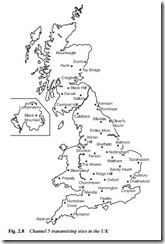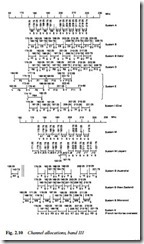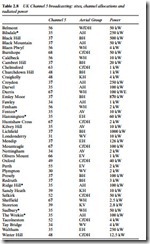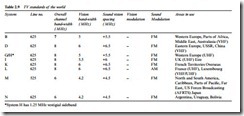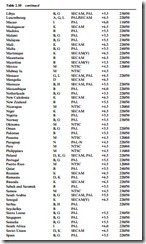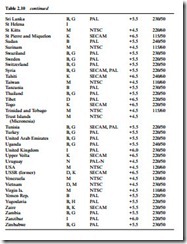CHANNEL FIVE BROADCASTING
Channel 5 began TV broadcasts in the UK in early 1997, with limitations on radiated power and station siting to avoid interference with other transmissions (of established services) here and in nearby countries. Some Channel 5 transmitters are co-sited with those of the BBC and ITV, while others, for operational reasons, have their own sites, see Fig. 2.8. In general Channel 5 radiation power is lower than for BBC/ITV transmissions, and its channel may differ in receiving aerial group from the other services in a co-sited group. These and the fact that many Channel 5 transmissions are on UHF channels 35 and 37 (clashing with the modulator frequencies of older home VCRs and satellite receivers) can make terrestrial reception difficult in some areas; an attractive alternative is the Channel 5 simulcast on Astra satellite 1D transponder 63, 10. 92075 GHz. Table 2.8 gives details of the Channel 5 terrestrial transmitters.
WORLDWIDE TV STANDARDS
While System I (625/50/PAL) with 6 MHz sound spacing is used in the UK and Eire there are many other permutations of scanning rates, encoding systems and transmission parameters in use around the world for terrestrial transmissions. The three main colour encoding systems are NTSC, generally used with the 525/60 standard; SECAM, used with 625/50 scanning in France and Eastern Europe; and PAL in the rest of Europe, Australia and some South American countries. Characteristics of the main systems in current use are given in Table 2.9, and a comprehensive worldwide listing of countries with their systems in Table 2.10. European VHF channel allocations are shown in Figs 2.9 and 2.10. Vision carrier frequencies per channel are listed in Table 2.11. Some guidance on converting between standards is given in the next chapter.
The use of videorecorders and cassettes in various countries gives rise to many questions. Provided the scanning standards for line and field, and the encoding system is the same, a cassette recorded on a machine of a given format (i.e. VHS, Video-8 etc.) will replay satisfactorily elsewhere in the world on a machine of the same format. Thus a UK-made tape will replay in Jordan, for example, where PAL System B is in use. Video machines themselves, however, are less versatile since they incorporate, in effect, a TV transmitter and receiver/demodulator, and require a specific mains voltage to power them. Some are internally switchable between 230, 220, 117 and 110 V, which embraces all the world’s domestic electricity supply
systems. There are multi-standard videorecorders manufactured, mainly intended for the Middle Eastern market, which can deal with video signals in both VHF and UHF bands, and encoded to PAL, SECAM or NTSC standards. Not all of them have facilities for the
6 MHz sound spacing of the I system, however, and in NTSC mode many utilise a ‘hybrid’ system called ‘NTSC 4.43’ for use with which the TV’s colour decoder must be specially adapted or designed. A conventional multi-standard VCR can only replay a tape in the form in which it was recorded unless it incorporates a digital field store. It is important to understand the capabilities of the machine at the time of purchase if multi-standard use is envisaged.
